Franco Scaglione, “My Father” His Life in the Words of His Daughter Giovanna
As told to Robert Little, Renzo Carbonaro, Vladimir Pajevic and Ulrich Zensen
Copyright: 8 November 2017 All World Rights Reserved
Republished with permissions with changes to suit the format of VeloceToday
Read Part 1
Franco Scaglione’s daughter Giovanna has chosen to share with you, the interested reader, her personal love and deep affection for her father and hopes you will become more familiar with him as she begins her narration of her personal glimpses of her father.
Aerodynamics Studies
Scaglione’s reserved and minimalistic personality compelled him to draw heavenly automotive shapes according to his own innate sense of form and creativity.
His dream was of an automobile that, like a falling drop of rainwater in the air, could glide along with only the slightest turbulence and with the least friction possible…a car that could travel quickly without disturbing the outside air or creating whistling noises inside the cockpit.
Pencil in his left hand, Scaglione would draw the shapes his mind visualized, with unique personal goals in mind to achieve the most ideal aesthetic and aerodynamic state of perfection. According to Giovanna,
“Aerodynamic studies were his great passion but always with a special eye toward elegance and style; he used to meld technique with beauty. He was a very experienced designer in all figurative art.
“When there was an air show he used to go and see it with great interest. He conveyed to me that great love for airplanes. When he was very young he studied aerodynamics, how the planes were built and their evolution. His knowledge about aerodynamic forces became the basis for his automotive engineering background.
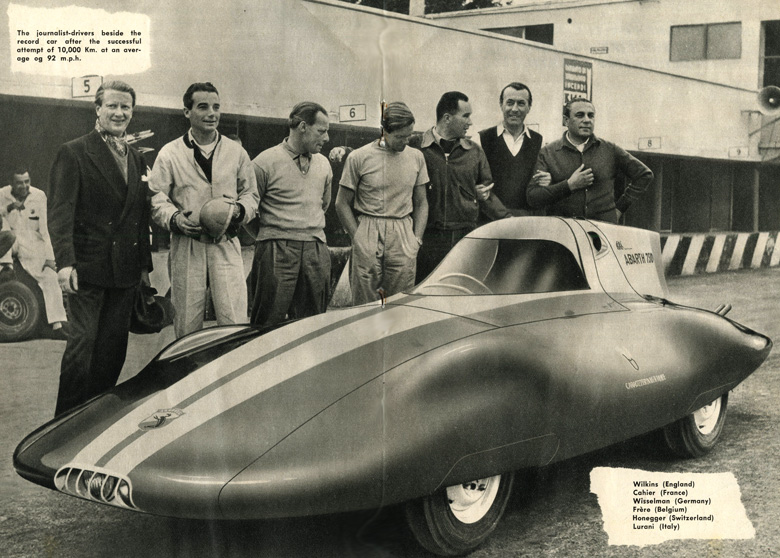
Journalists after the June, 1956 H class record attempt with the 750cc Abarth record car designed by Scaglione for Bertone. From Abarth Brochure.
“Babbo (affectionate Florentine term for ‘Dad’ or ‘Father’) was a great lover of airplanes when he was a young boy. He would have absolutely loved to enter the Italian Air Force but he was not accepted because of his near-sightedness. He entered the University of Bologna in 1938 after achieving his aerodynamics degree in 1937 from the University of Florence. This new course of study combined his Italian military service obligation simultaneously with this degree program in Aeronautic Engineering. The outbreak of war interrupted this second degree program from being completed. He came back home at the end of the war after being held a prisoner by the British in India for five years.”
Arts and sports
“Babbo was a very lover of arts in general but I don’t think that he was influenced by somebody in a special way. He loved to read, to go to theater and listen to classic music. He had a vivid, active mind and a formidable memory. He was always curious about everything and interested in everything. He always took care of everything at home. He loved very much to cook, too!
“He loved very much to practice sports… swimming for example. He taught me to swim when I was only one year old! Another activity he loved a lot was rowing. In Torino there is a big river, Fiume Po. When I was eight years old he brought me with him on the river and he instructed me on the art of rowing. Our boat was a wooden racing model with two mobile seats. We used to leave from Murazzi, an area on the river where we had our boat, we rowed up to Moncalieri, about ten kilometers from Torino and back home. All along the year, on Saturday afternoon we always went on the river with our boat. We both loved it.
“We spent a lot of time walking, long and beautiful walks, speaking about everything. But Babbo did not always have much time to spend with me and my mother, because of the pressure of his work, but what was important was not the quantity, but the quality of our time together …as in any situation.”
Postwar life in Italy
After spending one year with his mother in the south of Italy in Calabria Scaglione relocated to Bologna in 1947 and began his initial job searches by writing letters to men who controlled the Italian design industry. A few relatives lived in the Bologna area in the event he needed family help or support.
Among the largest design houses of the day…Pinin Farina and Bertone were polite in their negative responses to the personal contacts he had cultivated with them. Most firms chose not to respond to him at all.
Without a job in 1948 he turned to the clothing design trade. While in Bologna he designed men’s and women’s clothing and made enough money to marry Maria Luisa on September 25, 1948 and begin to live very comfortably and fashionably.
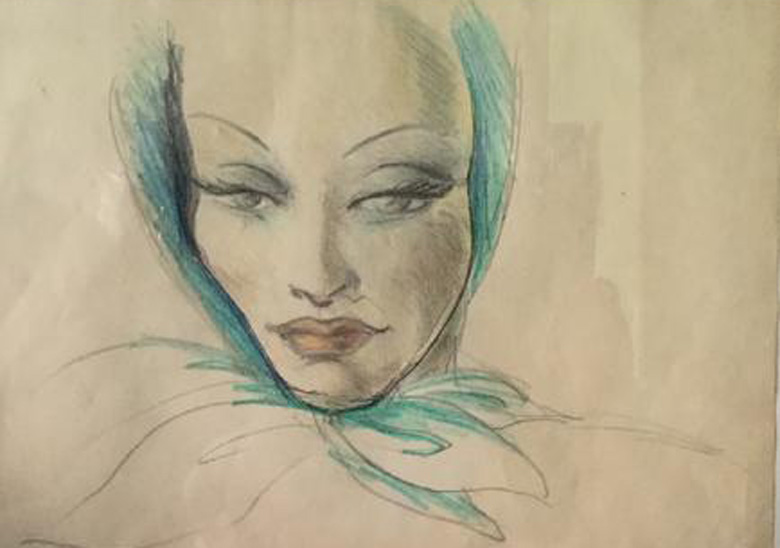
Maria Luisa Scaglione drawn by her loving husband Franco is currently in Giovanna’s living room. Courtesy of the Giovanna Scaglione archives
“While working in the upper echelon of the Italian clothing trade during the period 1948-1949, Scaglione continued to try to enter the budding automobile design industry. His chosen method was modified to approach and present his credentials through the personal contacts he would generate… visiting various auto shows and other occasions and meeting important principals such as Balbo, Stanguellini, Pinin Farina, Bertone and Enzo Ferrari. He chose not to write letters to these people and not to wait idly by for responses which might have never arrived.
“At each point of contact he would arrange for a private appointment with those principals to display his skills and knowledge. After 1951 he didn’t make any other dress models as he had a lot of work with car drawings.”
A Career with Cars
“Before the outbreak of WWII in 1935, Babbo acquired his first car; it was a gift by his mother and his uncle… a Fiat Balilla 3 speed. After the war, he bought another Balilla like the first one.
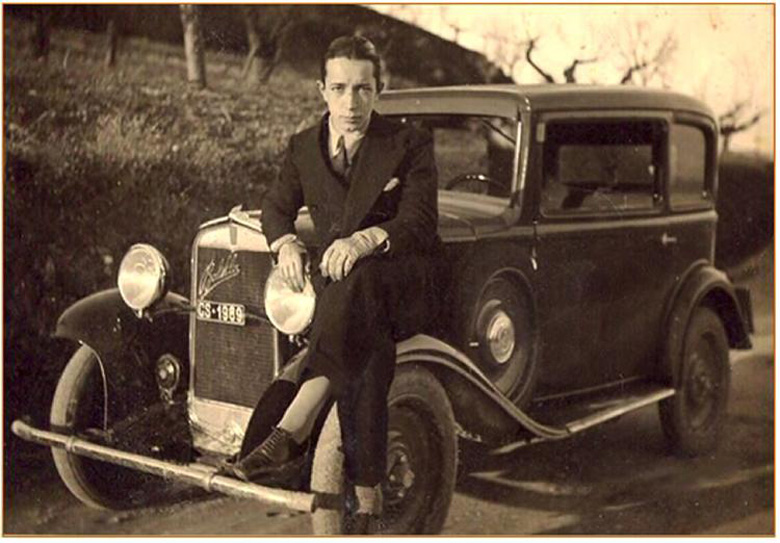
19-year-old Franco Scaglione with his new Fiat Balilla in 1935. Courtesy Giovanna Scaglione Archives
“When he went on to Torino to begin his automobile designer career in 1951 he continued using it for years. But he loved much more to use public transport to get around, for relaxing and for comfort. But very often he preferred to walk also for long distances.
“My mother didn’t get a car driver’s license, not for fear but because she was inattentive she said. She used to say: ‘I don’t want to cause an accident with anybody in my car. Women at the wheel are dangerous!’
“Later Babbo bought one of the first Alfa Romeo Giulietta cars (a white Sprint…his own design… first series in 1954) that he used until he stopped driving due to declining health.”
“Yes, Babbo used to speak about politics, but always in a quiet manner, with great respect of the other person’s opinions. Every day, at home or on bus or on the train going to work he read the newspaper “La Stampa” edited in Torino. We often spoke about politics at home and everybody expressed their own opinion. He never took part in any political organization, however.
“He didn’t like to play cards or other table games. Sometimes he played cards with his friends but only to spend free time. He loved a lot to listen to the radio… novels or classic music.
“In those years people used to go to play in Casinos, but my Babbo went there only two or three times with Mr. Bertone. He could play chess, but he was bored by the game. Nobody in our home was a fan of games. My mother, however, played the card game ‘solitaire’ sometimes.”
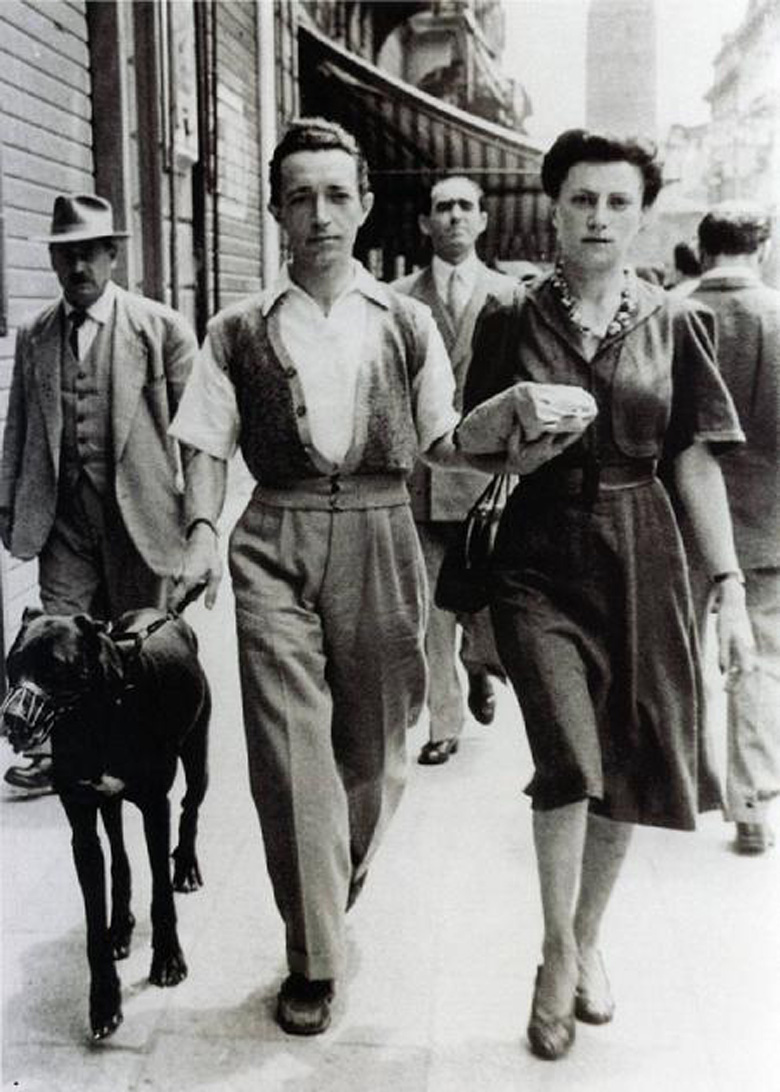
Mr. and Mrs. Franco Scaglione and their pet ‘Frida’ on the streets of Bologna 1948. Courtesy of the Giovanna Scaglione archives
“The photo was taken at Bologna in Via Ugo Bassi. My uncle took it. My dad loved the animals as well as my mom. A passion that has also passed to me. When a dog or cat was found he was looking for a suitable name. In Torino we found an Irish deserted setter, a poor lean beast who was scared. We named it ‘Dry.’ The dog you see in the above picture was a Danish (big size about 70 kg). In the house we have always had dogs and cats together. All abandoned animals. Babbo took them and brought them home. We got to have 5 dogs and 7 cats. How much love and joy they brought home!”
Franco Scaglione had a lifelong love for animals and birds of all descriptions and conveyed this appreciation of wildlife to his wife Maria Luisa and daughter Giovanna:
“I think that when my mother was pregnant with me (still in Bologna in early 1950), walking through Babbo’s street my mother noticed two little boys playing with some emphasis at a fountain. Curiously, he approached and realized that the children had found a small bird and tried to drown him. Babbo took the little boy’s hands away from the bird, scolded them well and took the bird away to save him. With mom he brought him to the vet and entrusted to him to make sure the little bird found a way to freedom. When a dog or cat was found he was always looking for a suitable name.
Soon two years later his first and only child was born…Giovanna…when he was 34 years of age.
Growing up with Babbo
Giovanna proudly relates:
“I have the dress my Babbo drew for my mother for their engagement; when I married I asked to my mother to wear it, a beautiful dress that fitted very well after 33 years. I also have the blouse she wore when they married and again drawn by my father…a wonderful blouse.
“I also have some dress models made by my father for avant garde fashion houses when he worked in Bologna. He drew also my wedding dress and the little hat I had on my head. He was a ‘Prince of Taste’ about dressing. A simple design but always chic.
“My father spoke and wrote perfectly four languages: English, French, German, Spanish and he knew enough Greek to get along well. These languages he was very passionate about it and never had difficulty learning them.
“He wanted me to study languages but I was not fit at all for them. My goal was to study Arts, to have a degree in architecture and to work in archeology. But Babbo didn’t agree to that, and in those times parents decided for their sons and daughters; he wanted me to become a simultaneous translator; that decision didn’t get realized and displeasure got to both of us. I managed to graduate without honor and without glory !!! So everything went away …we both were disappointed but for different reasons!”
Off to the races
“I used to go to Monza to see the Grand Prix with my Babbo and my mother. We had special tickets for the private boxes above the pit lane. If possible I used to go into the pit lane.
“Babbo had many friends among the mechanics and drivers, but I was too young and I have no memory of that period. When I became older I used to go to see the Grand Prix with some friends of mine. Babbo used to go to see other Grand Prix races with Nuccio Bertone, as they were both very enthusiastic race fans and also attended for their work. Babbo was not interested in rallies, however.
“I have a very beautiful memory: It was 1967 and the Intermeccanica IMX was being introduced to the public on the Monza circuit. Before the event I persuaded my Babbo to have a test drive with the car on the circuit. Of course it was not for me to drive… Babbo drove the car and we had a complete tour of the circuit. It was a wonderful experience and a great excitement I will never forget.”
Next, the beginning of Scaglione’s automotive design career
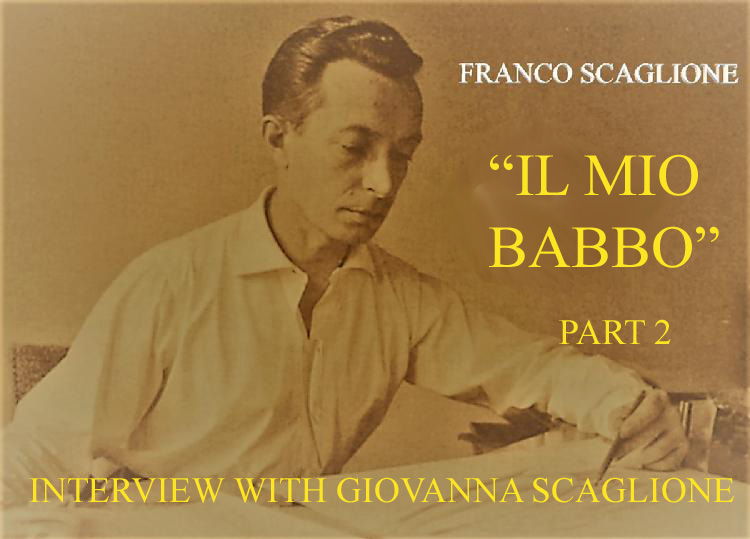
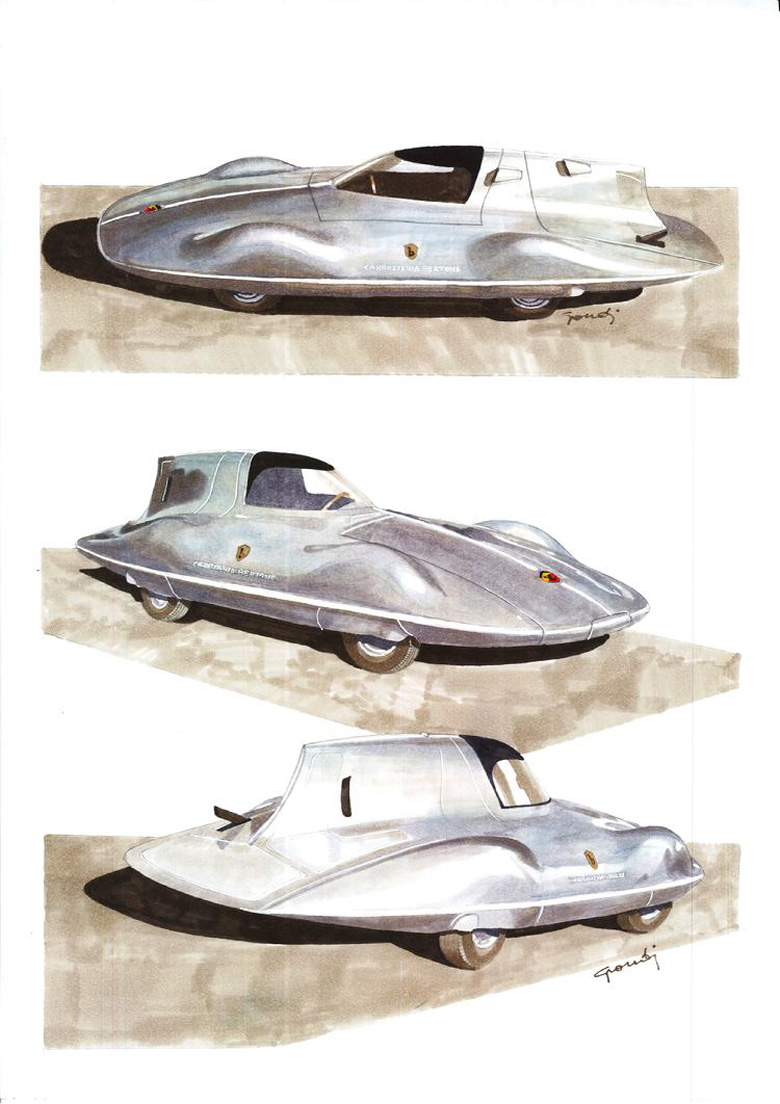
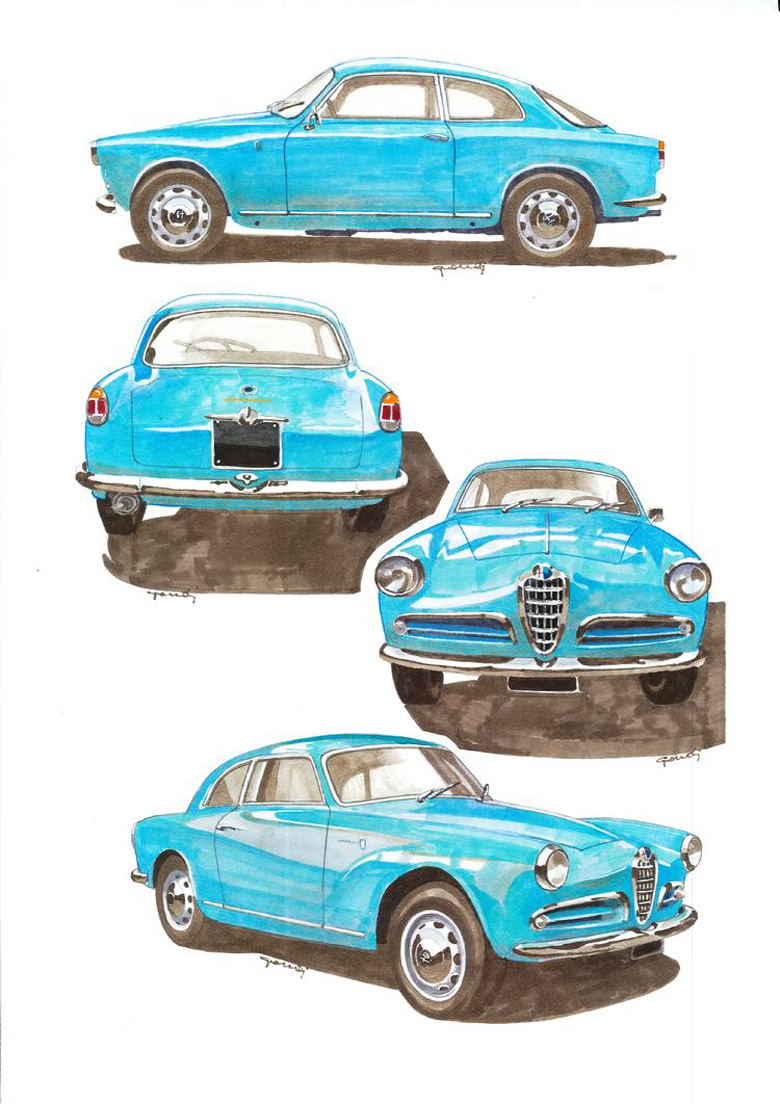
Very good to write about this very very special man who gave autodesign after the WW2 a boost. He is unic! So many special designs, together with Michelotti he made Italdesign in the fifties and sixties.
Wonderful insights on Franco Scaglione who ended up in obscurity in his final years. But the cars he designed live on and show what a “Prince of Taste” he really was!
Clearly, a man of impeccable taste.
Scaglione was indeed a man of impeccable taste and form with a clear understanding of aero as well. His streamliner designs for Bertone, so beautifully illustrated here by Massimo Grandi, were actually the inspiration of Bill Mitchell’s Sting Ray coupes. When Mitchell returned from the Turin show in late 1955 he brought with him a handful of photos he had taken there. He laid those out before his young designers in Research B at GM Styling and said, “This is the direction I wish to explore.” You can see the clear delineation of Scaglione’s streamliner form in the XP 87 Stingray concept that debuted at Marlboro in 1959. Mitchell too had a great eye for design! Peter Brock
I love the myth of the raindrop being an aerodynamically efficient shape. Not true of course. However looking at fish can teach us about efficient shapes, and Scaglione looks to have known that.